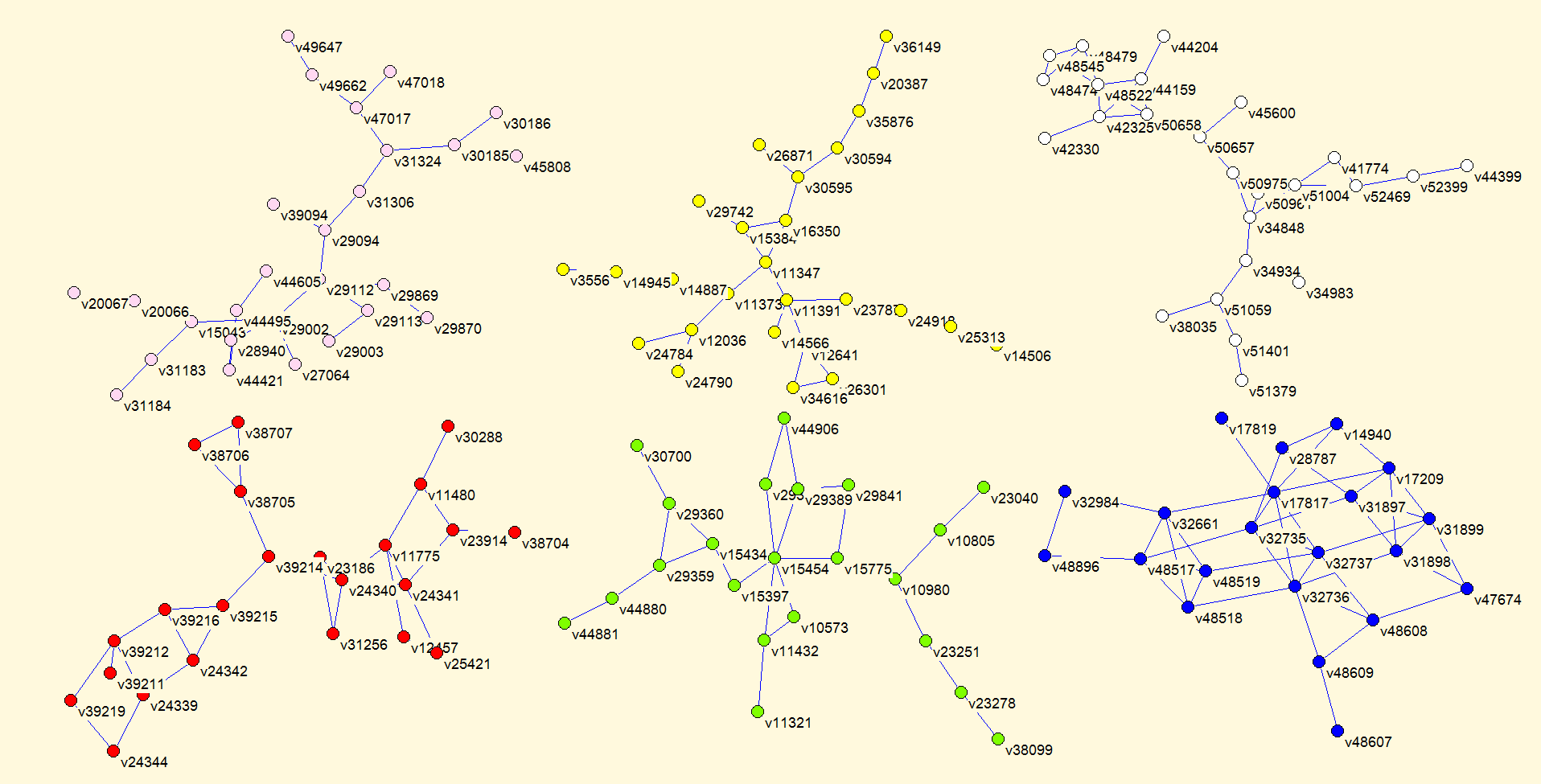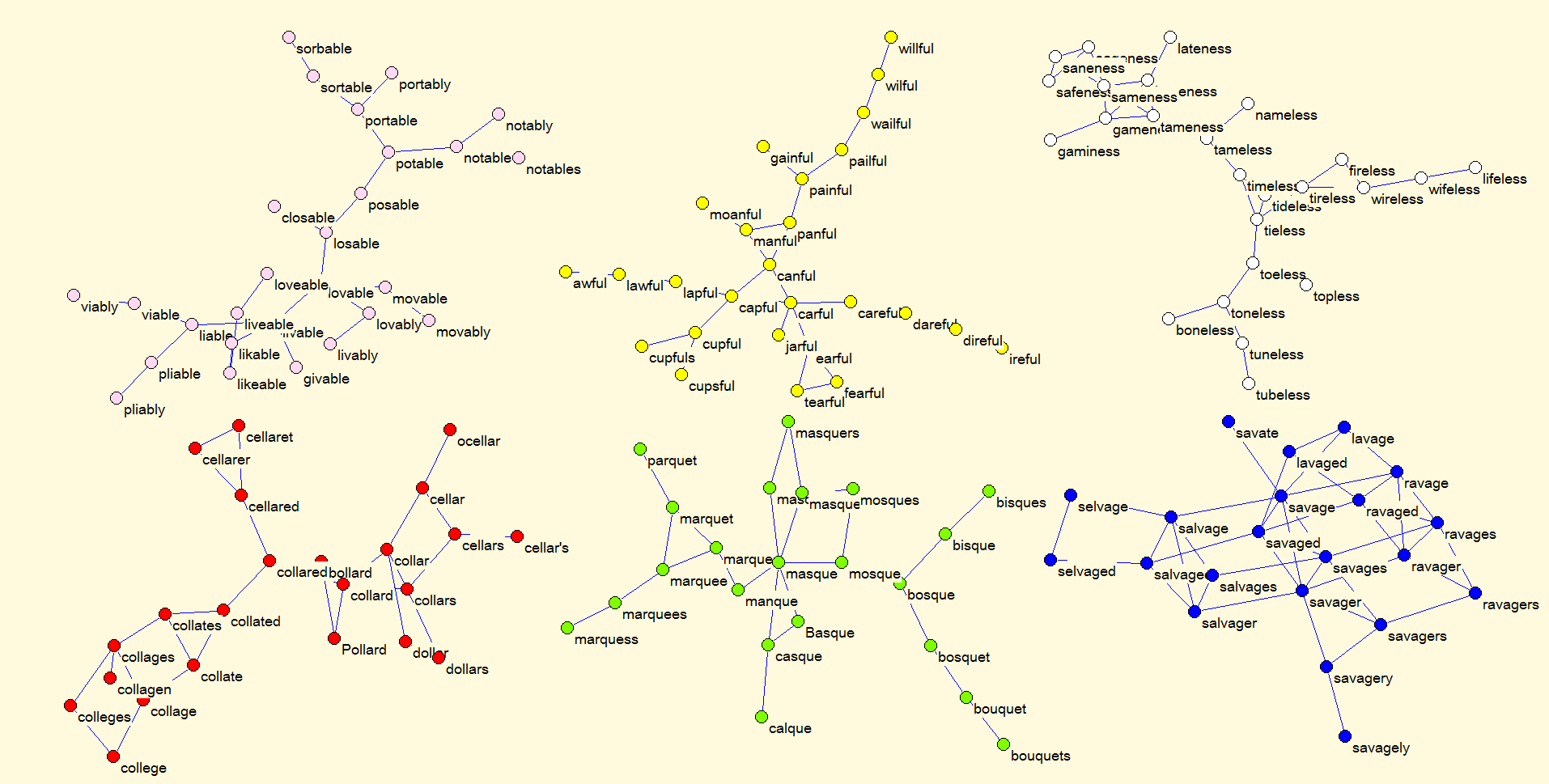Example 1 of Pajek-XXL usage
|
For demonstration purposes we will use dictionary network dic28.net.
This network represents connections among English words in a dictionary.
It was generated from Knuth's dictionary.
Two words are connected by an edge if we can
reach one from the other by - changing a single character (e. g., work - word) - adding / removing a single character (e. g., ever - fever). There exist 52,652 words (vertices in a network) having 2 up to 8 characters in the dictionary. The obtained network has 89038 edges. |
Although the typical use of Pajek-XXL will be demonstrated on a relatively small network, that can be handled with Pajek as well, the same steps can be performed on networks with some 100's of millions of vertices as well.
- Load dic28.net to Pajek-XXL.
When read in Pajek-XXL vertices are described with sequential numbers (1-52652) only.
Vertex-ID drop-down menu is empty - vertex IDs are equal to vertex numbers (v1-v52652). - In Pajek-XXL compute weakly connected components of the network (Network / Create Partition / Components / Weak).
After obtaining partition as a result, sort clusters in the partition in decreasing order according to frequencies
(Partition / Canonical Partition / with Decreasing Frequencies).
In this way Partition / Info gives us a more clear overview of the sizes of components:
Cluster Freq Freq% CumFreq CumFreq% Represent ------------------------------------------------ 1 24831 47.1606 24831 47.1606 2 2 1125 2.1367 25956 49.2973 20602 3 27 0.0513 25983 49.3486 15043 4 26 0.0494 26009 49.3979 3556 5 25 0.0475 26034 49.4454 34848 6 23 0.0437 26057 49.4891 11480 7 22 0.0418 26079 49.5309 10573 8 21 0.0399 26100 49.5708 14940 9 19 0.0361 26119 49.6069 11232 10 19 0.0361 26138 49.6429 14378 11 19 0.0361 26157 49.6790 25644 12 18 0.0342 26175 49.7132 10235 13 18 0.0342 26193 49.7474 16737 14 17 0.0323 26210 49.7797 11825 15 17 0.0323 26227 49.8120 12531 16 16 0.0304 26243 49.8424 25130 17 15 0.0285 26258 49.8709 9893 18 15 0.0285 26273 49.8993 24931 19 15 0.0285 26288 49.9278 12486 20 15 0.0285 26303 49.9563 12235 ...Now you can extract and analyse separately the largest component (which is now - when components are sorted in decreasing order - the first one). The size of the largest component is less than 50% of the size of the original network.
Or, you can select and visualize some smaller components. Lets extract components 3-8 (with sizes from 27 down to 21 vertices).
Run Operations / Network+Partition / Extract SubNetwork and select 3-8 in the dialog box.
(In case that you would work with a huge network you would get additional question Create a new Network as a result? If the old network is not needed anymore answer No is recommended to free a lot of memory space.)
The obtained extracted network has 144 vertices, which are renumbered to 1-144 again. To identify them we get the following values in Vertex-ID pop-down menu (double click VertexID drop down menu to see):1. 3556 2. 10573 3. 10805 4. 10980 5. 11321 6. 11347 7. 11373 8. 11391 9. 11432 10. 11480 ... 142. 51401 143. 52399 144. 52469
Explanation: Vertex with number 1 is vertex v3556 in dic28.net, vertex with number 2 is vertex v10573, etc.
|
Option 1: You can call program Pajek directly from Pajek-XXL with the extracted network where labels are replaced with the right ones (stored in the file). For that purpose use the command: Tools / Pajek / Send Network to Pajek / +Add Vertex Labels from File(s). |
|
Option 2: If you for some reason do not want to call Pajek directly from Pajek-XXL (maybe not enough memory is available to have Pajek-XXL and Pajek running at the same time), you can save the obtained subnetwork first, later call Pajek, load the network and replace labels with the real ones. Sequence of steps to do this is the following one:
|
By saving the obtained network in a usual way to a NET file, you get a NET file with additional information (labels, coordinates):
*Vertices 144 1 "awful" 0.4051 0.0491 0.5000 2 "Basque" 0.5323 0.7016 0.5000 3 "bisque" 0.4669 0.8832 0.5000 4 "bosque" 0.4743 0.8199 0.5000 5 "calque" 0.4921 0.6524 0.5000 ... 142 "tuneless" 0.7075 0.2723 0.5000 143 "wifeless" 0.8587 0.1067 0.5000 144 "wireless" 0.8508 0.1668 0.5000 *Edges 2 3 1 3 4 1 1 3 1 ...Next example

